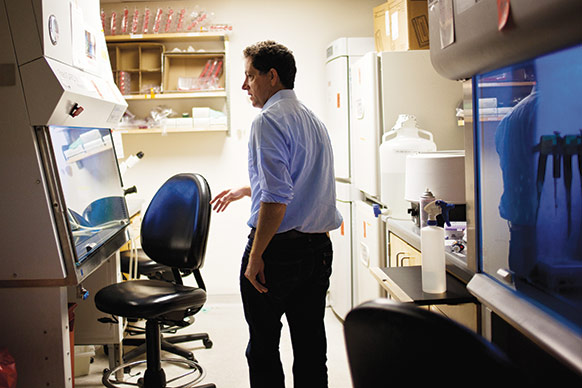
IRIS login | Reed College home Volume 91, No. 3: September 2012
The Molecular Assassin (continued)

Ace of Kinase. Kevan Shokat ’86 uses kinases to jam the internal signaling of cancer cells.
Photo by Ariel Zambelich
Kevan believed passionately that his chemical approach held huge potential. Unfortunately, Schultz’s prediction proved witheringly accurate. When his postdoctoral research was done, Kevan sat in the academic marketplace like damaged goods, while peers with more orthodox interests landed jobs. “That was the hardest time,” he says, “I got no job offers.” Finally, he landed an assistant position at Princeton, which he accepted, uprooting Deborah’s medical practice and taking Kasra, then two years old, in tow to New Jersey.
In 1997, he and three collaborators published a paper in the Proceedings of the National Academy of Sciences that would become a signature work. Using genetic engineering, the team created a mutant cell line from Rous sarcoma, a well-studied retroviral chicken cancer that served as their experiment’s control group. The mutant expressed a kinase, v-Src (for “virus-sarcoma” and pronounced “vee-sark”) that would serve as their target. Next, they crafted a series of special molecules to probe the phosphate binding site of the v-Src kinase present in their mutated strain. One of the test molecules, [ɣ 32P]N6-(cyclohexyl) ATP, bound strongly to the mutant cell’s v-Src kinase’s phosphate–binding site, blocking it from receiving or transferring chemical energy. No other kinases found in either cell line showed strong affinity for the test molecule.
While the nominal objective of the paper, advancing the understanding of kinases in Rous sarcoma, was amply satisfied, the dry, scientific language of the article obscured its true significance. In the conclusion, the authors somewhat coyly predicted that if this technique were to work out with other kinases, “it might be possible to systematically begin to dissect the complex proximal signaling cascades controlled by cellular tyrosine kinases.”
Kevan and his colleagues had demonstrated it was possible to craft small molecules to probe the inner workings of living cells, inventing a powerful new technique to study cell biology that also provided a much straighter path from the laboratory to the doctor’s clinic.
“He built really clever tools, multiple tools,” says Schultz, his adviser at Berkeley. “Elegant solutions that really picked an important biological problem and used chemistry and molecular science in a way that nobody had ever thought about doing.”
The techniques Kevan began inventing at Princeton have been widely adopted by academic and commercial researchers alike because drugs that target kinases offer the promise of extreme specificity. Compared to conventional chemotherapeutic drugs, which mow down healthy and cancerous cells alike in a statistically driven war of attrition, kinase inhibitors attack diseased cells only, leaving healthy cells unscathed.
“Right now,” he says, “this is probably the mainstream approach for cancer. Twenty years ago, nobody thought you could make a drug specific and potent enough to inhibit the kinases.” Pharmaceutical companies large and small are using the techniques he devised to bring kinase inhibitors to market. “Now it’s a race,” he says. “Who can make the most selective, best drug that’s orally stable, gets across your bloodstream, inhibits potently, and can get the money, the clinical trials, and the patients? Right now, there are so many potential drugs out there, there are not enough patients! You couldn’t test all the ideas.”
In 2006, he coauthored a paper that demonstrated that the mTOR (for “mammalian Target Of Rapamycin” kinase), implicated in several types of cancer, could be chemically blocked. In 2007, he cofounded a pharmaceutical company, Intellikine, which licensed and built on this idea. The company’s two marquee compounds, INK128 and INK1117, attack two broad types of cancer by inhibiting kinase signals in the mTOR and PI3K (phosphoinositide 3-kinase) pathways, respectively. These drugs, which have cleared phase I clinical trials (setting safe doses and proving human safety), showed significant results in patients, both blocking cancer growth, and, in the case of INK128, interrupting metastasis, the devastating spread of cancer cells throughout the body. “We had one patient,” says Intellikine’s cofounder Troy Wilson, “with renal cell carcinoma [whose] tumors shrank dramatically after two cycles of our drug. That doesn’t happen spontaneously.”
In December 2011, Japanese firm Takeda Pharmaceuticals snapped up Intellikine for $190 million. If Intellikine’s drugs make it to market, the deal rises to a total of $310 million.
Not bad for two molecules.
![]()
Thirty years after Chemistry 101 and well into his own career, Kevan might be given a pass for mad-genius abrasiveness, but by all accounts he remains a pleasure to work with. “I’ve been in this business for 15 years, started six different companies, with a lot of different people,” Wilson says. “Kevan, for a lot of reasons, stands head and shoulders above all of them. He’s not only one of the most insightful, thoughtful, brilliant people I’ve ever met, but he’s just a genuinely good human being who always does the right thing... I can think of nobody I’d rather have as a scientific founder.”
Amid the excitement of new discoveries, he remains an active teacher, running his lab as a workshop where students dedicate themselves to inquiry with few constraints. “What I like about running the lab is getting to know people, getting to know their strengths, and then helping them direct themselves onto the path that they find most compelling. That, I think is true for Reed. Nobody tells you you can’t do something, or you can’t go in some direction.”
Kevan encourages his students to pursue their ideas, just as he did. “He’s a great scientist,” notes Joe Kliegman ’06, one of his graduate students, “but he’s also a compassionate human. That’s really important.”
The week we went to press, another of Kevan’s papers had been accepted by Nature, describing a new paradigm, attacking multiple kinase receptors simultaneously. No longer content to address single kinases, he’s studying them as a network, touching on information theory to go after the problem. “I think it really is going to be a big paper...” he says, and you can almost hear the wheels turning in his head.
- Previous Page
- 1
- 2
- Next Page


LATEST COMMENTS
steve-jobs-1976 I knew Steve Jobs when he was on the second floor of Quincy. (Fall...
Utnapishtim - 2 weeks ago
Prof. Mason Drukman [political science 1964–70] This is gold, pure gold. God bless, Prof. Drukman.
puredog - 1 month ago
virginia-davis-1965 Such a good friend & compatriot in the day of Satyricon...
czarchasm - 4 months ago
John Peara Baba 1990 John died of a broken heart from losing his mom and then his...
kodachrome - 7 months ago
Carol Sawyer 1962 Who wrote this obit? I'm writing something about Carol Sawyer...
MsLaurie Pepper - 8 months ago
William W. Wissman MAT 1969 ...and THREE sisters. Sabra, the oldest, Mary, the middle, and...
riclf - 10 months ago